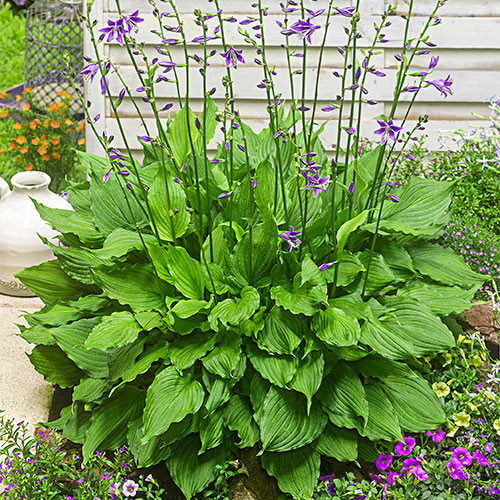

Generally, blue-leaved hostas require shadier conditions, to keep their color, than gold- and white-leaved varieties, and green-leaved hostas are the most sun-tolerant. Hostas grow best in morning sun and afternoon shade. Plant your hosta in an area with shade or filtered light. You can also water your hosta consistently to keep the moisture level in the right range. Hostas really appreciate humidity, especially during the growing season, so the best growing conditions for your hosta plant would be an area with high moisture. Hostas are considered to be winter-hardy in most temperate climates, but cannot tolerate winters with far below-freezing temperatures in Zones 1 and 2.

Hostas are able to thrive in nearly any climate-cold, hot, even in places with pollution, such as city streetscapes. Hostas cannot be planted underwater-they will thrive near water features, but not inside of them. Before planting, add compost to your soil for additional richness and to assist in drainage. While they don't appreciate soggy soil, they will thrive particularly well in soil that is consistently watered. Hosta plants prefer well-drained soil rich in nutrients. Some hostas have very long bloom times, and the foliage remains intact from spring far into autumn. Hostas will typically bloom in mid-summer, with scapes sprouting from the plants a few weeks before blooming. While hostas are all about the foliage, these plants do grow attractive flowers, and some species can have flowers that are quite large. Both of these hostas are perfect for containers! Smaller varieties like June Hosta and Blue Mouse Ears feature the elegant, heart-shaped leaves of the hosta family with a compact and tidy habit. Lipstick Blonde hosta features red stems and nodding, lavender flowers.Ĭurly-edged hostas, like our favorite Silly String Hosta, add something completely unique to the garden, with interesting texture and wild, funky shapes. Yellow hosta stand out beautifully on rainy days, and many varieties have contrasting color on the flowers or stems. If you're looking for huge, leafy impact, consider giant hosta! Plants like Empress Wu can grow up to 4 feet tall and six feet wide, with leaves well over thirty inches. Giant hosta have an impressive footprint, thanks to their extra large leaves. Colossal Blue Hosta is an excellent example of this group. The blue-green color is absolutely striking, and these plants generally have a very pleasant, mounded shape.

Plants described as members of the Tardiana group are generally large-leaved cultivars with blue-green leaves. Let's look at some of our favorite types of hosta. There's also a wide variety of shape and size among hosta cultivars-you could truly build an entire garden out of hosta alone. There are so many hostas to choose from, where should you begin? Common hosta plant colors include green, white, yellow, or blue foliage, and many hosta have white or purple flowers.
#Hostas with purple flowers how to#
Learn more about how to care for your hosta plants below! These plants grow in a wide variety of sizes, so you'll be sure to find a hosta plant perfect for your landscape. Hosta are among the easiest plants to grow, in part due to their ability to thrive in polluted or urban environments. Different varieties of hosta have leaves appearing in shades of blue, yellow, and green, and may also feature interesting ribbing or patterns. These plants are actually members of the asparagus family, and you'll see the resemblance in their tall flower scapes.

Hostas are known for their often large, tropical-appearing leaves, and tall scapes of small flowers. Hostas Hostas are a versatile perennial plant capable of thriving in shaded areas and damp, rich gardens.


 0 kommentar(er)
0 kommentar(er)
